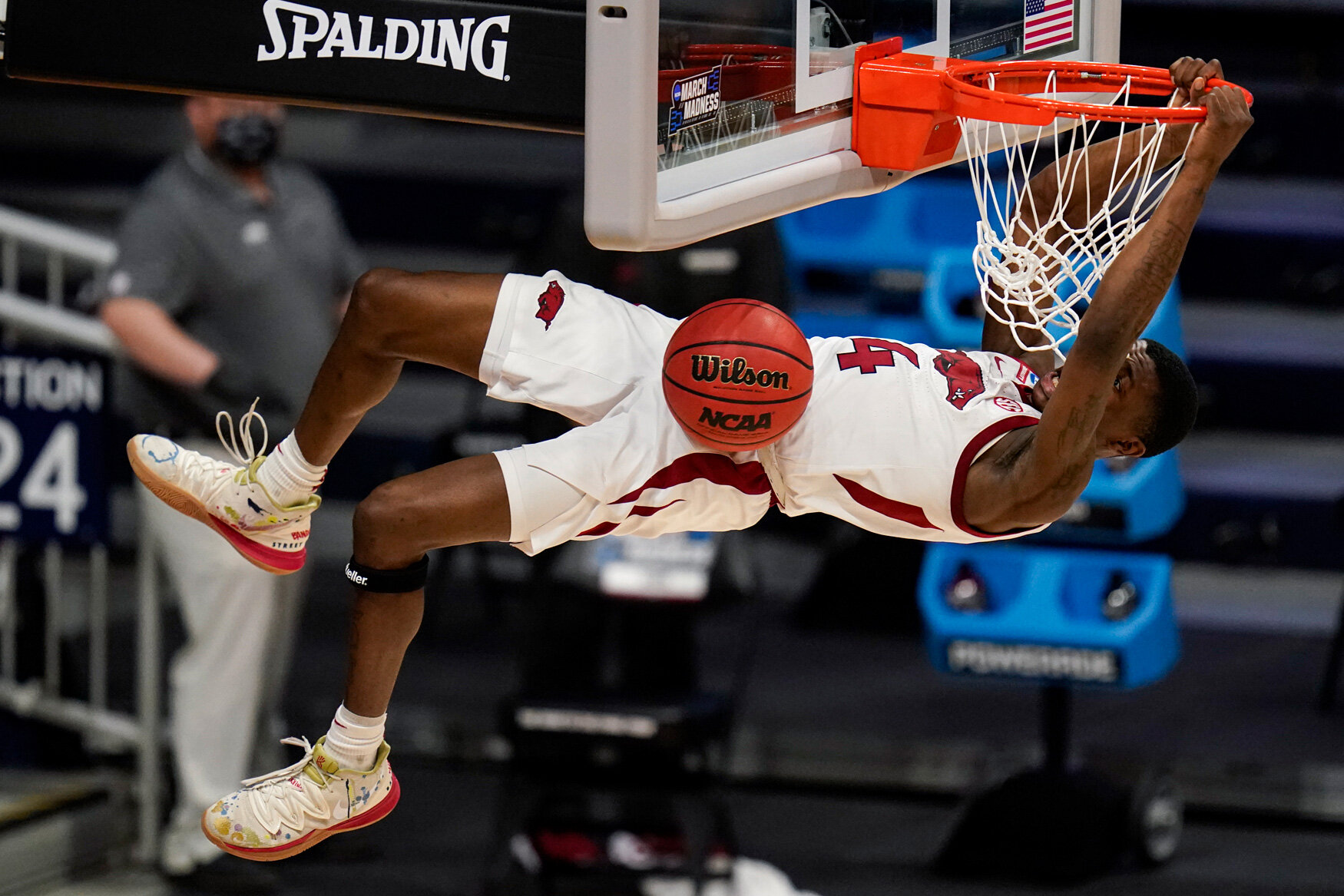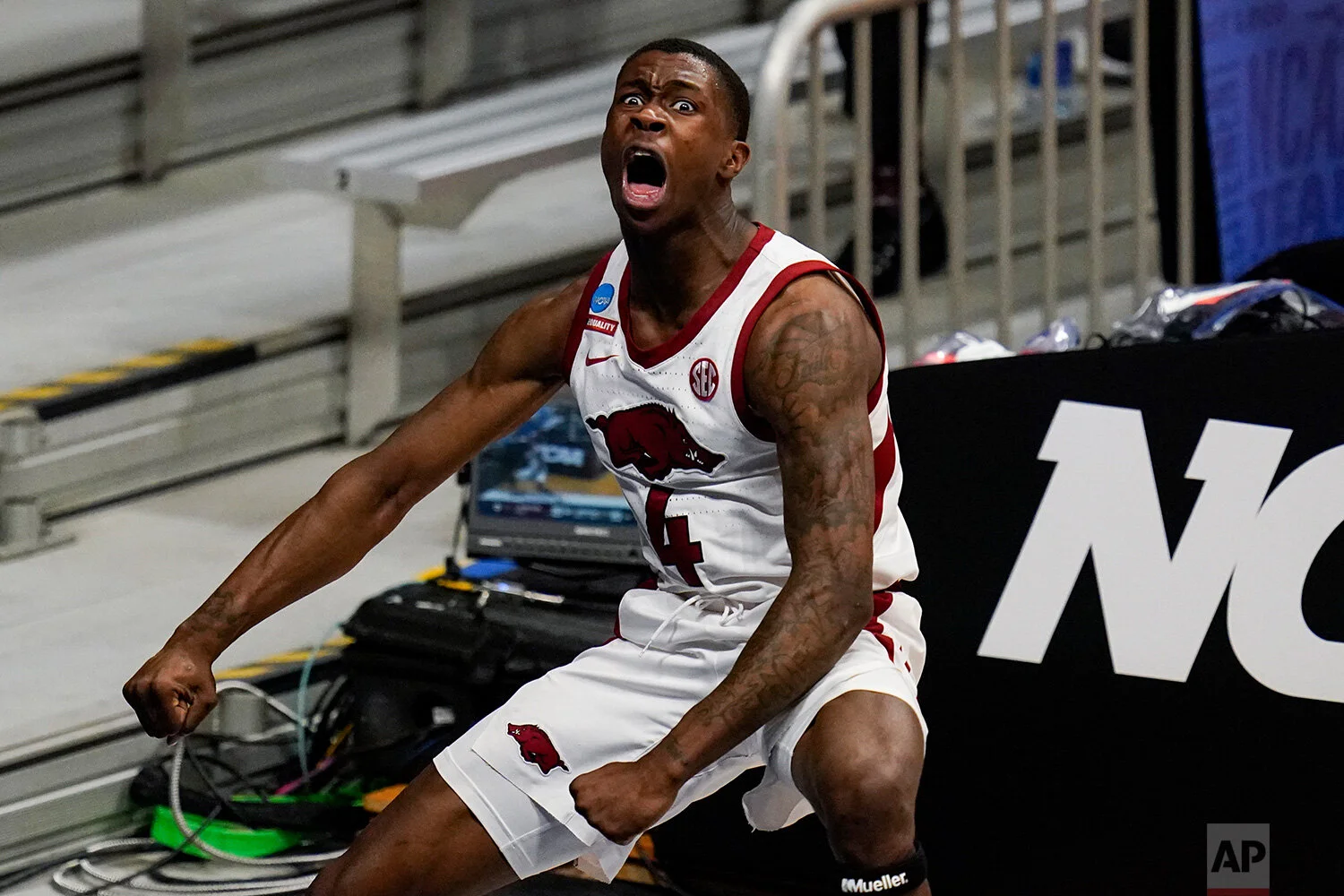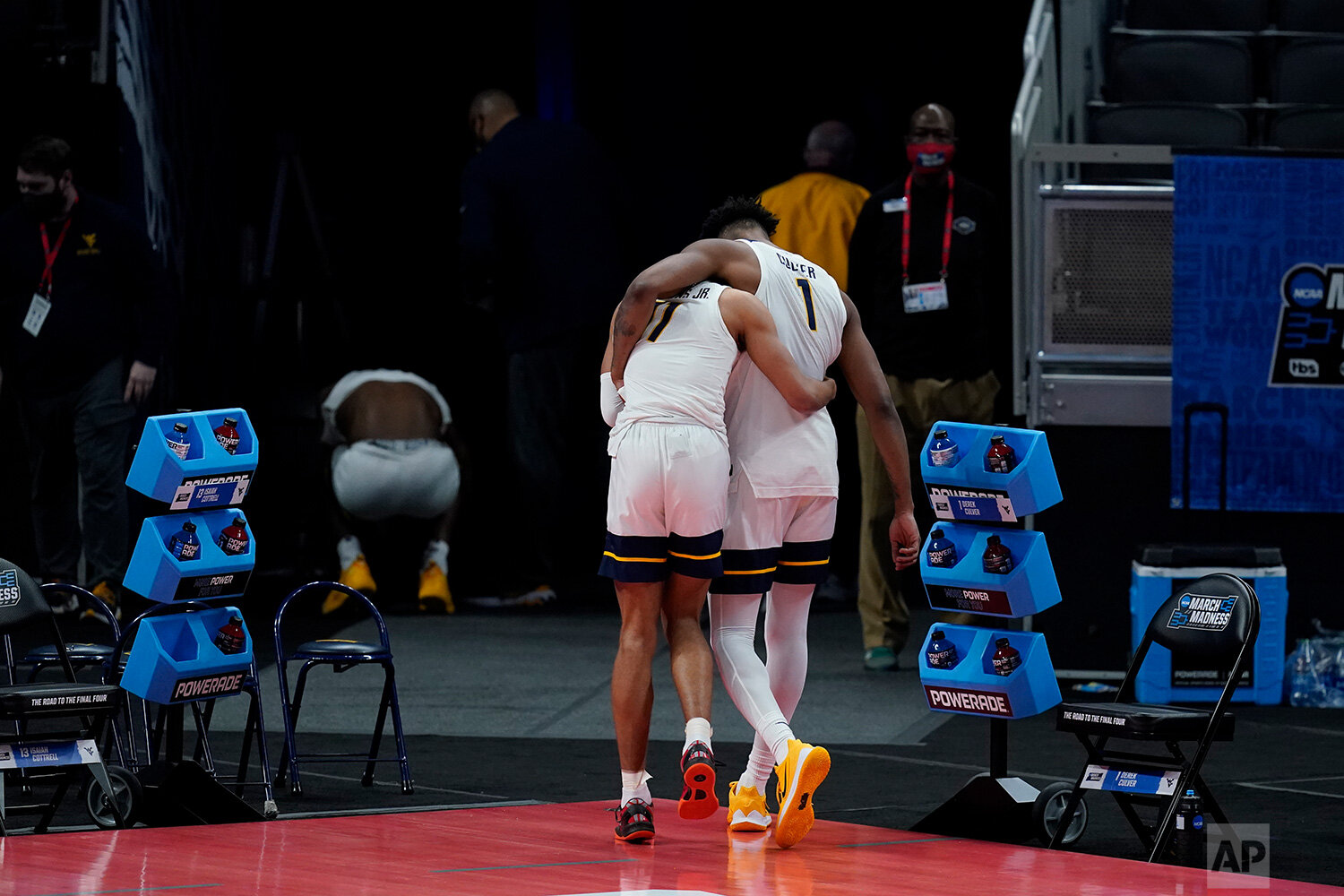Emotion and technique collide for AP photographers covering March Madness

The Shot is a monthly series showcasing top photojournalism from staff photographers at The Associated Press.
Each month, AP photographers will share the stories behind some of their iconic imagery.
In the first post of this series, photographers Michael Conroy and Darron Cummings discuss the first week of the March Madness NCAA basketball tournament.
Produced by AP news staff. The presenting sponsor was not involved in the creation of this content.
Michael Conroy
This will be my 13th NCAA Final Four and to say that this year’s tournament is different would be an understatement.
The entire 67 game tournament is being held in Indiana due to the COVID-19 Pandemic. The games are being held with limited attendance and have a completely different look and feel than in years past. Darron Cummings and I are the two AP staff photographers in Indianapolis, and when rumors surfaced in January that the NCAA was considering playing the entire tournament in Central Indiana, we both knew we would be very busy and would need to bring in additional staff and freelancers to cover all the games. I was looking forward to shooting every round of the tournament as its one of my favorite events to cover.
Photographers don’t have the access that we normally we have to the games. We are limited to two photographers per game, and we are shooting from elevated positions as we have no access to the court where we normally shoot the games due to restrictions put on photographers by the NCAA. We’re only allowed into the venues about an hour before the game and aren’t able to place any remote cameras around the venues to capture views we can’t physically be during the games. For my last Final Four, we had three photographers on the court, one in an elevated position, plus two on site editors and a couple members of our technical support team. Personally, I had the two cameras in my hands and five remote cameras in various places just to give you an example of how different it is this year for the AP.
We’re just trying to make the most of what we have.
“In this case I was happy to have the longer lens to capture his emotion and limit the distracting background as much as possible. In the NCAA tournament, I think that the reaction and emotion images are more important than the action.”
For the second-round game between Arkansas and Texas Tech, I was positioned about center court in the stands about 20 rows up off the court. I was mainly using the Sony a9 II with a 400mm 2.8 from this spot to cover the game. When shooting courtside my primary lens would have been a 70-200mm 2.8 with the 400mm getting occasional use. This combination is light enough to hand hold and give me the ability to easily follow the action. During parts of the games, I add a 1.4 extender, which makes the 400mm a 560mm lens, to go even tighter on the action. With no fans in the lower areas around the court, the backgrounds are very cluttered, and this can be distracting in the photos.
Being in an elevated position, I’ve found using the flexible tracking focus on the A9 II is the most effective and allows you to keep the subject in focus and compose the photo as you wish. Also, as in most indoor venues, I prefer to set a custom white balance to provide the most accurate toning in the camera.
The dunk photo was one of those times I had the extender on. Arkansas had a 10-point lead and on a fast break, Davonte Davis went up for a dunk and pulled his body horizontal to the backboard. This is something you don’t see every game and being up in the stands at center court, I had a nice angle on it. I thought I was too tight since he went so wide, and I was using the extender, but I was able to keep him in the frame.
When play resumed Texas Tech missed a shot and Davis grabbed a rebound and headed straight to the bucket, scored and was fouled on the play and reacted towards the Arkansas fans. In this case I was happy to have the longer lens to capture his emotion and limit the distracting background as much as possible. In the NCAA tournament, I think that the reaction and emotion images are more important than the action.
I finally had a chance to quickly review some images on the camera and saw that both the dunk and the reaction looked pretty good. But it was at the next timeout that I had a chance to download them to my laptop and edit them before sending them to our customers that I saw that I made what I thought were a couple of pretty strong photos, adding the AP’s APTOPIX designation, before sending them out on the wire.
Arkansas went on to win 68-66.
Darron Cummings
Growing up in Indiana and working in Indiana, covering basketball is a given. Some high school gyms are bigger than some college gymnasiums. So, it was a perfect fit when the NCAA announced in January that the entire NCAA men’s basketball tournament was going to be held in Indianapolis. Four historic venues in the city were used along with the venues on the campus of Indiana and Purdue University.
Covering these games is far from normal. No court access and everything being shot is from elevated positions with a 400 or 600 millimeter lens. Normally while sitting on the court we use a 70-200 for under the near basket and a 300 for down court action. While on the court we have the ability of putting a wide angle remote in front of us or a fellow photographer for another angle on the action. But this is not the case. Remotes are not an option with the limited time and access that we have.
Normally we can get into the venues several hours before the games. During this NCAA tournament most everything is being photographed with one camera. I have mostly been photographing games in Bankers Life Fieldhouse (home of the Indiana Pacers) and Lucas Oil Stadium (home of the Indianapolis Colts and previous Final Four tournaments.)
“For the first few minutes the game was like a track meet with up and down action on both ends of the court. I had just photographed a player going up for a shot, then all of these players simultaneously reaching for a rebound.”
One always tries to limit the amount of frames that you shoot. In the days of film you always put in a new roll for end of game reaction. Today you put in a new card. The more you think about end of game reaction, the less you or an editor has to look at. The bottom line is to think about what you are shooting, just do not shoot for the sake of shooting images. Sony cameras allow so much versatility. We can photograph events with a higher ISO which allows for higher shutter speeds to stop the action. I usually try to photograph sporting events with at least a shutter speed of 2000. Then I adjust the ISO to have the smallest f-stop (F2.8 or 4 depending on the lens). That way the shallow depth of field helps to clean up backgrounds and keep the focus on the action or reaction.
When photographing games you look for clean backgrounds. Those are very limited with the photographic locations in this NCAA tournament. After a few action photos, I tried to look for reaction of players. You pay attention to players to how they react from early baskets or fouls. These are the players that normally react at the end of the game, win or lose. In the one photo of West Virginia players leaving the court, they had just been upset by Syracuse. I had one quick photo of Syracuse players celebrating, then I noticed a West Virginia player covering his face with his jersey. I had both celebration and dejection which is always a goal but does not always happen.
I went back to shooting the Syracuse celebration and then I noticed the two West Virginia players hugging as they left the court. This made for a much better moment and from the body language of the players walking off you can really feel for them. Let’s face it, this college basketball season was far from normal. The one thing I noticed in editing the sequence was a gentleman walking in front of the players and he was wearing a bright yellow jacket that was very distracting. I had to wait for the gentleman to blend more into the background before I was able to get the moment I wanted. In total I shot about 30 frames of the players walking off the court.
In the second photo, the game between West Virginia and Syracuse had just started. For the first few minutes the game was like a track meet with up and down action on both ends of the court. I had just photographed a player going up for a shot, then all of these players simultaneously reaching for a rebound. I had two frames of the rebound. I decided to crop into the photo just showing the basketball and the hands to give the members and our customers something different. A photo that could be used in several different ways. This is one of the moments that cropping makes a difference. I was happy to make a frame of just the hands and the basketball.
Follow AP photographers on Twitter
Spotlight is the blog of AP Images, the world’s largest collection of historical and contemporary photos.
Produced by AP news staff. The presenting sponsor was not involved in the creation of this content.








